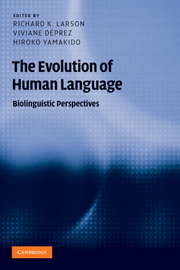Book contents
- Frontmatter
- Contents
- Figures
- Contributors
- Acknowledgments
- Introduction
- 1 The faculty of language: what is it, who has it, and how did it evolve?
- Part I Language architecture
- Part II Language and interface systems
- Part III Biological and neurological foundations
- Part IV Anthropological context
- 13 A putative role for language in the origin of human consciousness
- 14 On two incompatible theories of language evolution
- 15 On the evolution of language: implications of a new and general theory of human origins, properties, and history
- Notes
- References
- Index
14 - On two incompatible theories of language evolution
Published online by Cambridge University Press: 05 June 2012
- Frontmatter
- Contents
- Figures
- Contributors
- Acknowledgments
- Introduction
- 1 The faculty of language: what is it, who has it, and how did it evolve?
- Part I Language architecture
- Part II Language and interface systems
- Part III Biological and neurological foundations
- Part IV Anthropological context
- 13 A putative role for language in the origin of human consciousness
- 14 On two incompatible theories of language evolution
- 15 On the evolution of language: implications of a new and general theory of human origins, properties, and history
- Notes
- References
- Index
Summary
The Hauser-Chomsky-Fitch position
A recent article by Hauser, Chomsky and Fitch (2002, henceforth HCF) sought to instruct workers in the field of language evolution as to how they should proceed with further research. The authors distinguished between FLB, the faculty of language in its broad sense (including all factors, whether language-specific, human-specific, or otherwise, that go to make up all that lay persons mean by the term “language”) and FLN, the faculty of language in its narrow sense, limited to those aspects of FLB that are unique to both language and humans. In selecting their Hypothesis 3 over two alternative hypotheses, they wrote: “We propose in this hypothesis that FLN comprises only the core computational mechanisms of recursion as they appear in narrow syntax and the mapping to the interfaces” (HCF: 1573).
Subsequent debate (Pinker and Jackendoff 2005; Jackendoff and Pinker 2005; Fitch, Hauser, and Chomsky 2005) has focused mainly on the correct line of division between FLN and FLB – a definitional rather than a substantive issue, though admittedly one with non-trivial implications – leaving aside some more general evolutionary implications of HCF. The position of HCF may be briefly summarized as follows: language is composed of many factors, possibly all but one of which either preexisted language (that is, occurred in some form in prehuman, alingual species) or arose among human ancestors for functions other than language. Each of these factors evolved separately and presumably through normal evolutionary processes.
- Type
- Chapter
- Information
- The Evolution of Human LanguageBiolinguistic Perspectives, pp. 199 - 210Publisher: Cambridge University PressPrint publication year: 2010
- 9
- Cited by



